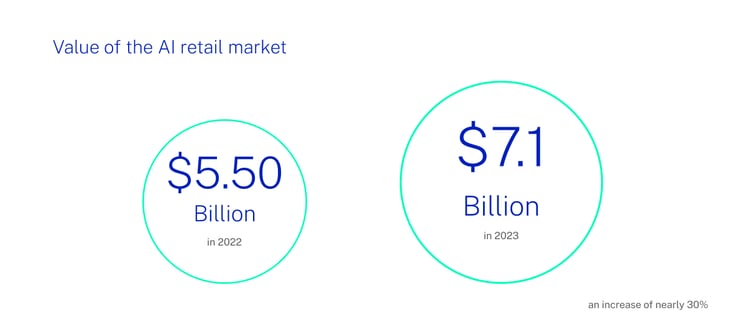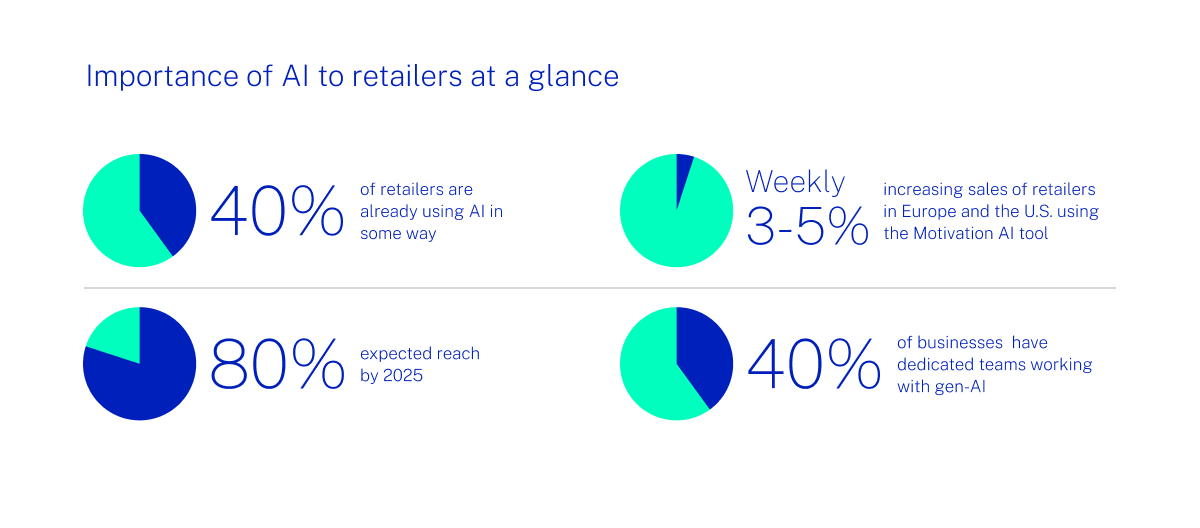A guide to AI in retail: Purpose, Benefits & Importance
As is the case in many other industries, the link between artificial intelligence and retail is getting stronger and stronger all the time. In 2023, the value of AI in the retail market worldwide reached $7.1 billion, an increase of nearly 30% in just a single year. This growth is likely to continue as AI becomes even more mainstream, and as consumers become increasingly aware of AI’s capabilities and what it can do for them.

However, making the most of the opportunities of AI in retail is proving to be easier said than done, which means that retail is lagging behind some other sectors in AI adoption. For example, integrating AI functions with legacy technologies has proved to be challenging, as has ensuring that customer data is kept secured throughout any AI use. It’s also been difficult in some cases to adapt AI into complex retail models, and to ensure that it’s well-aligned with consumer behavior.
As AI continues to evolve, its impact on retail could redefine the shopping experience, making this an exciting era for retailers and consumers alike. And with the right understanding of AI in retail, and with insight of how it can be applied at a practical level, the potential for it to open up new customer experiences and revenue opportunities is huge. This blog explores the purpose of AI in retail, the key benefits it can deliver, and why it can be important for both physical stores and eCommerce operations.
What is AI in retail?
AI in retail refers to the ways in which computers and machine learning can perform tasks faster, more efficiently and with greater insight that humans would be able to do. In the main, artificial intelligence and retail come together to make predictions that enable better outcomes, for retailers and customers alike.
The range of those outcomes is substantial: it could be delivering more personalized communications and experiences to customers, or it could be suggesting adjusted inventory levels in anticipation of new customer demand for certain products.
However, there are some practical barriers that are hindering the combination of artificial intelligence and retail. These include (and are not necessarily limited to): integrating AI into existing IT infrastructure, training staff to effectively use AI tools, and interpreting vast amounts of data. Retailers also face challenges in ensuring AI solutions are scalable and adaptable to market trends.
The purpose of AI and machine learning in retail
As AI is still relatively new, the possibilities of the technology in retail are still emerging, and are developing and improving all the time. It’s no surprise, therefore, that the value of the global market is expected to quadruple to around $39 billion over the next five years. Nonetheless, a number of practical applications with real-world benefits are already gaining traction:
 Forecasting and inventory management
Forecasting and inventory management
Accurate retail forecasting has always been very difficult with forecast error being as high as 32% on average, as it has often comes down to human intuition and educated guessing over future customer intentions or emerging trends. AI is taking much of the guesswork out of this process by analyzing retail data far more deeply than has previously been possible. It can provide suggestions of which products are likely to sell particularly well (or badly) and when, helping retailers optimize their supply levels and avoid having to discount excess stock to move it on.
.jpg?width=1200&height=545&name=Graph%2002%20(1).jpg)
Connected to this is the ability to automate wider inventory management, where AI can track sales levels and automatically reorder stock, so that availability and demand are always balanced.
 Cashier less technology
Cashier less technology
Amazon has been at the forefront of efforts to remove the cashier process in physical stores. Its ‘Just Walk Out’ concept uses AI systems and connected cameras that follow customers around the store and keep track of the items they take off the shelves. When customers finish shopping and walk out, they are then charged automatically.
While Amazon has recently closed some of its ‘Go’ stores that were piloting Just Walk Out, it’s now providing the technology to other retailers, including stores at theme parks, sports stadiums and airports, all places where speed of service is especially important. Several other companies are also busy developing similar technology, such as Trigo, who have rolled out cashierless technology at REWE Pick&Go convenience stores in Germany.
 Creating slick customer experiences
Creating slick customer experiences
Customers all over the world increasingly expect to be marketed to and communicated with at an individual, personalized level. They want information and offers that are tailored to their preferences - and if they don’t get those experiences from a particular retailer, then they’ll shop around and go to a competitor where they will.
AI is instrumental in delivering highly personalized retail experiences. Its ability to find patterns in customer behavior and buying data means it can uncover insights that marketing and comms teams may previously have been unaware of. This means that the effectiveness of personalized comms can increase even further, and generate more positive actions from customers. Furthermore, AI can do this at far greater scale than humans can, meaning more customers can get more personalization, more of the time.
 Synchronizing online and offline retail
Synchronizing online and offline retail
AI may only exist in the digital world, but it can also be used to augment in-store experiences, and to bring online and offline retail closer together. For example, AI-based shop assistants can be used on smartphones by customers to guide them around stores, and connect them to more detailed information about products as they browse.
 Enabling interactive chat
Enabling interactive chat
Conversational AI that can mimic human speech is delivering new levels of customer service, helping customers search for their preferred items and resolving any problems or queries that arise. As the AI tool serves more customers, it learns from the data and customer input involved, helping it refine its responses and serve customers even better in the future. AI can also be used to contact customers after they’ve left the store, reminding them of items they’ve been interested in and targeting them with specific offers.
What are the main benefits of AI in retail?
When AI in retail is done right, the effect on a retail operation - and on the service that customers receive - can be transformative:
 Improved customer satisfaction
Improved customer satisfaction
According to Salesforce, 66% of consumers want businesses to understand their specific requirements and expectations, so the value of positive and personalized customer experiences can’t be overstated. At the same time, smooth customer service - supported by AI chatbots - can remove much of the stress from customer experiences when something goes wrong. This can make a major difference to brand perception, and encourage greater customer loyalty at a time when it’s never been easier to shop around.
 Stock efficiency
Stock efficiency
Being able to rationalize stock and inventory levels can be a major driver of cost efficiency for retailers. If retailers can better match stock and reordering to demand - especially if they can accurately predict future demands in this area - then they can avoid wasting money by ordering too much, or lost sales opportunities through ordering too little.
 Reduced overheads
Reduced overheads
Connected to the previous point, AI can also be used to proactively monitor every stage of the supply chain, and spring into action as soon as there is a problem or anomaly. Whereas there might be delays when problems have to be sorted out by humans, AI can immediately rectify any issues to minimize the knock-on impact throughout the supply chain. This can reduce or even eliminate any unnecessary cost overheads involved in the supply chain from start to finish.
 Better security
Better security
AI can be beneficial from a security perspective, both for eCommerce and for physical stores. In the online marketplace, AI-based security tools can help keep customer and payment data secure; this is especially important in the area of regulations like GDPR, and increasing penalties for data breaches and areas of non-compliance. But AI can also be used for security in-store, too: facial recognition can help spot thieves, and immediately identify suspicious activity, such as when an item is placed inside a bag or clothing. This allows store staff to alert the authorities and take action immediately, while the thief is still within the store.
The importance of AI for retailers
In our extensive experience of AI at Ciklum, we’ve found that some use cases for generative AI are more important than others. From the perspective of impacting customer experience, we believe the most effective applications are personalized marketing, customized product recommendations and virtual store design. Meanwhile, from the standpoint of operational efficiency, AI is proving particularly helpful with creating advanced troubleshooting guides, dynamic pricing models, and sentiment analysis for customer feedback.
 Keeping up with competition
Keeping up with competition
According to Analytics Insight, 40% of retailers are already using AI in some way, and this is expected to reach 80% by 2025. So it’s clear that there is no time to lose to get on board with the winning combination of artificial intelligence and retail.
Early adopters of AI in retail are already gaining a competitive edge: for example, retailers in Europe and the U.S. using the Motivation AI tool ar increasing sales by 3-5% within a matter of weeks. On the other side of the coin, those retailers that don’t will find themselves losing market share, customer interest and revenue very quickly.
 Related industry implementation
Related industry implementation
Honing AI in retail will give businesses a platform to apply the technology in other areas of their operations, such as finance, HR, payroll and others. CapGemini research has found that 40% of businesses already have dedicated teams and budgets to work with generative AI, meaning that investing in artificial intelligence and retail can have significant payoffs in other areas, too.
 AI with parcel delivery
AI with parcel delivery
One of the areas where many retail journeys fall down is the very last one: delivery. Customers may be able to buy the products they want, but then can’t get them delivered in a timely and convenient manner - and then find it difficult to resolve the issues that emerge. Customer service chatbots, powered by AI, can play a vital role in efficiently dealing with customer issues, as well as proactively providing real-time delivery updates that leave customers feeling valued and informed.

In summary: the future of AI in retail and consumer behavior
As this blog demonstrates, artificial intelligence and retail will be very closely linked in the months and years to come; AI will be instrumental in delivering on ever-rising customer expectations, and the need for businesses to manage costs. Furthermore, in the future, AI is expected to further personalize shopping experiences and integrate with technologies like AR and VR. Retailers should also prepare for emerging technologies like IoT and edge computing, which will enhance real-time data processing and customer engagement.
Of course, AI is emerging technology, and the best way to make the most of it is to work with an expert technology partner that understands how to apply it for maximum effect. At Ciklum, we work with artificial intelligence and retail businesses like yours every day, pinpointing exactly how, why and where AI solutions should be applied. That way, you can maximize your AI investment and generate better experiences for your customers, and better outcomes for your bottom line. Get in touch with our team to find out more and discuss your specific goals for AI in retail, or read our blog on how to become a data-driven retail organization.
You may also like
Subscribe to receive our exclusive newsletter with the latest news and trends
Subscribe to receive our exclusive newsletter with the latest news and trends
Want to reach out directly to us?
hello@ciklum.com
© Ciklum 2002-2023. All rights reserved



